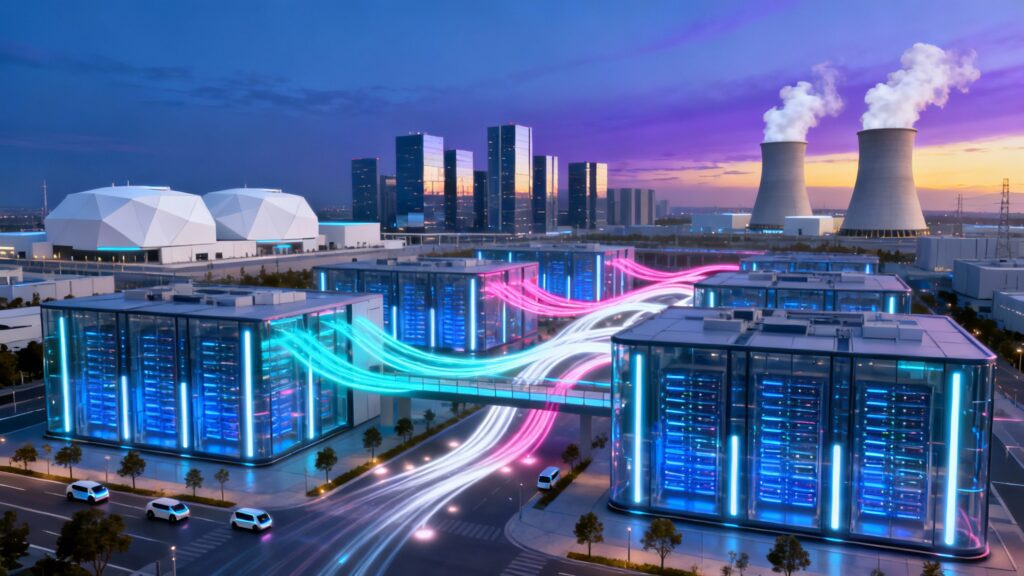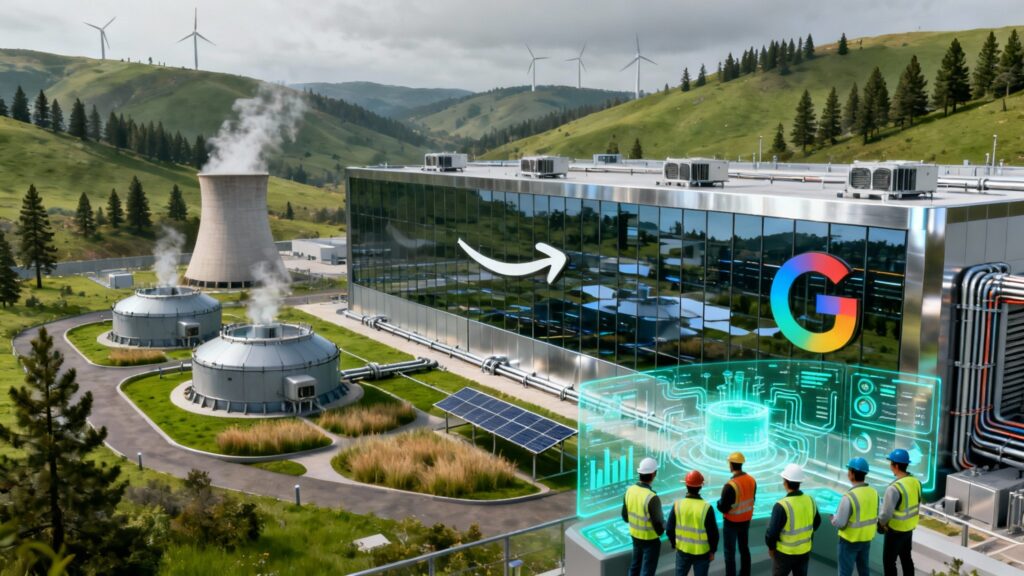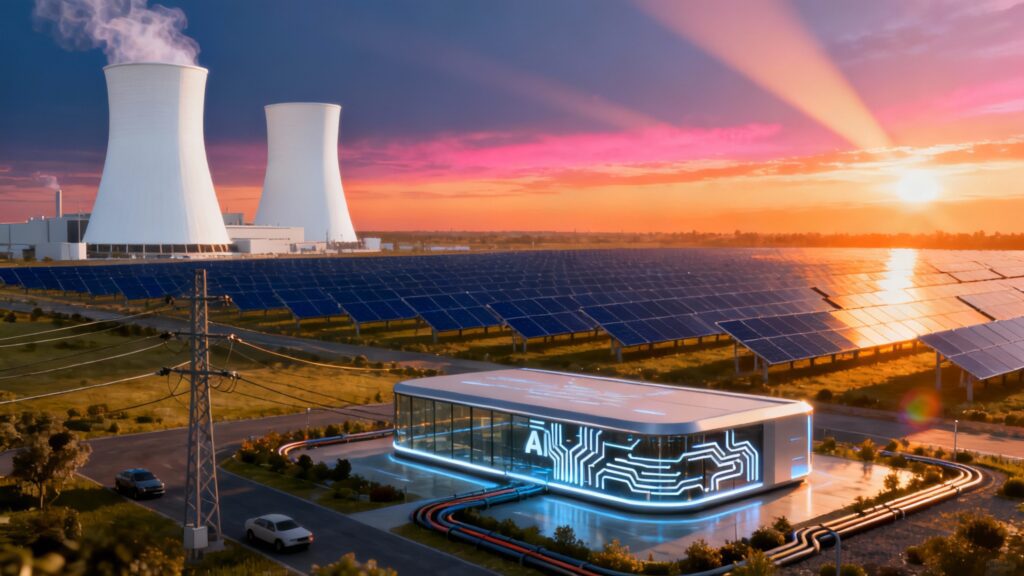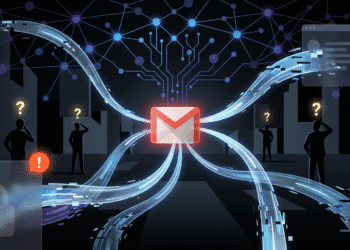Nuclear Power Emerges as the Unlikely Hero of AI’s Energy Crisis

The artificial intelligence revolution is here, and it’s hungry ravenously hungry for electricity. If you haven’t noticed the shift yet, your power bill might soon tell the story. As massive data centers spring up across America to fuel AI’s explosive growth, they’re competing with homes and businesses for electricity, driving up costs and testing the limits of an aging power grid. But Silicon Valley thinks it has found the answer: nuclear energy.
The AI Boom’s Hidden Cost
Remember when ChatGPT first launched? That moment marked more than just a technological milestone. It triggered an energy crisis that most people didn’t see coming. According to the International Energy Agency, a typical AI-focused data center now consumes as much electricity as 100,000 homes. The largest facilities? They devour 20 times that amount.
Here’s a startling comparison: a single ChatGPT query requires roughly 10 times the energy needed for a Google search. Multiply that by billions of queries daily, and you start to understand the scale of the problem.
Goldman Sachs projects that data center power demand will increase 160% by 2030 alone. Meanwhile, the Department of Energy estimates that data centers will consume more than 12% of total US electricity by 2028, up from just 4.4% in 2023. That’s not a gradual increase it’s an explosion.
Your Energy Bill Feels the Squeeze
The impact isn’t theoretical anymore. According to a recent Bloomberg analysis, monthly electricity costs in areas near data centers are now 267% higher than just five years ago. That’s not a typo. While overall inflation has climbed about 25% during the same period, energy costs near these facilities have skyrocketed more than tenfold that rate.
“Without mitigation, the data centers sucking up all the load is going to make things really expensive for the rest of Americans,” said David Crane, chief executive officer of Generate Capital, in an interview with The Daily Upside.
Enter Nuclear: The Comeback Kid
This is where nuclear energy enters the picture. After decades of being shunned in the United States following accidents like Three Mile Island and Chernobyl, nuclear power is experiencing an unlikely renaissance. Big Tech is betting big on it.
The numbers tell the story. A Bloomberg Intelligence report predicts that soaring power demand from AI will spur $350 billion in nuclear spending in the US by 2050. That investment is expected to increase America’s nuclear energy output by 63%.
“We’re in a very serious bind. We’ve already tapped out traditional oil and gas technologies,” Kevin Kong, founder and CEO of AI-driven nuclear compliance platform Everstar, told The Daily Upside. “Renewables are not dense enough… Data centers run 24/7, and are extremely power-dense. And so the only technology that’s left that was overlooked and under-invested in is nuclear.”
Why Nuclear Makes Sense for AI
Nuclear power offers something that wind and solar simply can’t: constant, reliable energy around the clock. Data centers don’t sleep. They need power 24/7, 365 days a year. Solar panels don’t generate electricity at night. Wind turbines sit idle when the air is still. But nuclear reactors? They keep humming.
According to the Department of Energy, nuclear operates at full capacity more than any other energy source. Current nuclear plants operate 18 to 24 months at a stretch, with refueling outages lasting only a few weeks planned far in advance so alternate power sources can be arranged.
There’s another compelling reason: nuclear energy is carbon-free. Tech giants like Microsoft, Google, Amazon, and Meta have all made ambitious climate commitments. They’ve pledged to reach net-zero emissions or carbon-free energy within the next couple of decades. Nuclear helps them square that circle.
Big Tech Goes Nuclear
The announcements have come fast and furious over the past year. In September 2024, Microsoft signed a groundbreaking 20-year deal with Constellation Energy to restart Three Mile Island Unit 1 yes, that Three Mile Island. The reactor, which wasn’t involved in the infamous 1979 accident, will provide 835 megawatts of electricity exclusively to Microsoft’s data centers.
“This agreement is a major milestone in Microsoft’s efforts to help decarbonize the grid in support of our commitment to become carbon negative,” said Bobby Hollis, Microsoft’s VP of Energy, in a statement to NBC News.
The plant, which shut down in 2019 due to poor economics, is expected to come back online in 2028. It will be renamed the Crane Clean Energy Center. Constellation will invest $1.6 billion to restart the dormant reactor.
Amazon and Google Join the Nuclear Race

Not to be outdone, Amazon jumped into the nuclear game with both feet. In October 2024, the company led a $500 million financing round for X-energy, a Maryland-based startup developing small modular reactors (SMRs). These next-generation reactors are smaller, potentially safer, and designed to be mass-produced.
Amazon also signed a deal with Energy Northwest, a utility in Washington state, to fund the initial phase of an X-energy SMR project. The project could generate 320 megawatts initially, with potential expansion to 960 megawatts just enough to power a single large AI data center.
Google, meanwhile, inked a deal with Kairos Power for up to 500 megawatts of electricity by 2035. Kairos is developing molten-salt-cooled reactors and recently received construction approval from the US Nuclear Regulatory Commission for two demonstration reactors.
“Nuclear energy provides 24/7 power,” explains Dan Stout, founder of Advanced Nuclear Advisors, in an interview with IEEE Spectrum. “In the 2030s, the grid will have less coal and there will be some constraints on gas. So nuclear energy’s power density and carbon-free high reliability is attractive.”
The Promise of Small Modular Reactors
Much of the excitement centers on SMRs the next generation of nuclear technology. Unlike traditional gigawatt-scale plants that take a decade or more to build, SMRs promise faster deployment and lower costs through factory manufacturing.
“It takes 10 years, in the best case, to build that gigawatt-scale plant,” Matt Loszak, co-founder and CEO of SMR startup Aalo Atomics, told The Daily Upside. “But if you mass manufacture [SMRs] in a factory, and you do more in parallel, you can actually deploy [SMRs] in a matter of a year or two instead of 10 years.”
Both X-energy and Kairos are developing reactors that use TRISO (tri-structural isotropic) particle fuel. This innovative fuel consists of uranium encapsulated in graphite kernels the size of poppy seeds, which are then loaded into golf ball-sized spheres. The structure enables the fuel to withstand extremely high temperatures, making meltdowns virtually impossible.
The Reality Check: Timing Is Everything
Here’s the catch: nuclear power won’t solve AI’s energy crisis anytime soon. That 63% increase in nuclear output? It’s not expected until 2050. The first SMRs won’t come online until the early 2030s at the earliest. But AI data centers need power now.
“There are needs on different time scales,” Patrick White, former research director at the Nuclear Innovation Alliance, told MIT Technology Review. “Many of these tech companies will require large amounts of power in the next three to five years, but building new nuclear plants can take close to a decade.”
This timing mismatch means that even as tech companies tout their nuclear ambitions, they’re actually relying on fossil fuels in the short term. Coal plants are staying open longer. New natural gas facilities are being built facilities that could operate for decades.
America’s Nuclear Struggles
The United States has a troubled history with nuclear development. When Plant Vogtle’s third reactor came online in 2023 in Georgia, it marked the first from-scratch new nuclear reactor in the US in more than three decades. The project came in seven years over schedule and $17 billion over budget more than double initial projections.
Currently, there are no nuclear reactors under construction in the US, according to the 2025 World Nuclear Industry Status Report. Compare that to China, which has 33 reactors under construction roughly half of all nuclear reactors being built globally. Goldman Sachs predicts China will surpass the US as the world’s leading nuclear energy producer by 2030.
There’s also a workforce problem. The US produced just 929 graduates in nuclear engineering in 2022, down 20% from a peak in 2015. Goldman Sachs estimates the country will need to triple its nuclear workforce to meet demand by 2050.
The French Model
Want to see what a nuclear-powered future looks like? Look at France. Nuclear energy accounts for roughly 67% of France’s total electricity supply, compared to just under 20% in the US. The result? Average day-ahead power prices in France fell to the lowest levels for September in two decades.
South Korea tells a similar story. With nuclear providing more than 30% of its power, the country has seen significant energy cost reductions.
“About 60% of the grid should be coming from nuclear; replace all natural gas and coal with nuclear,” Kong said. “That’s the goal: Make the United States look like France.”
The Cost Question
Not everyone is convinced nuclear will deliver cheap electricity. According to data from Wood Mackenzie cited by the Financial Times, the “levelized cost of energy” for SMRs will be around $182 per megawatt-hour in 2030. That compares to $133 per megawatt-hour from traditional nuclear plants, $126 for natural gas, and even less for wind and solar.
“SMRs are going to help with the hyperscalers,” Kong acknowledged, referring to the tech giants willing to pay premium prices for reliable, behind-the-meter energy. But he worries this focus on SMRs might divert resources from large-scale plants that could truly transform the grid.
“There’s a time and place for SMRs,” Kong said. “But if we say we want a cleaner form of energy for hospitals, for you and me every day, for turning on the kettle and for electric vehicles that are becoming more and more prevalent, then it really has to come from the gigawatt-class reactors.”
Bipartisan Support Speeds Things Up
One bright spot: nuclear energy enjoys rare bipartisan support in Washington. Both the Trump and Biden administrations moved to cut red tape, overhaul oversight processes, and pour capital into the nuclear industry.
“The whole goal here is by 2030 to have a factory set up that can actually output at least a gigawatt per year of capacity,” Loszak said, noting that streamlined regulatory frameworks have helped accelerate development timelines.
The US government views dominance in AI as crucial to continued economic and geopolitical leadership. That means ensuring adequate power supply is a national security issue, not just a business concern.
Challenges Remain
Nuclear power isn’t without challenges. Public perception remains a hurdle, with accidents like Chernobyl and Fukushima still fresh in collective memory. Licensing and permitting can take a decade or more. There are also questions about spent fuel storage and disposal.
The Department of Energy notes that spent nuclear fuel must be cooled after use and stored until an interim or permanent disposal pathway is established. Currently, the nation’s spent fuel is held at nuclear power plant sites across the country.
There are also concerns about water usage. Both nuclear plants and data centers require significant amounts of water for cooling. In Pennsylvania, where multiple nuclear facilities already operate along the Susquehanna River, some worry the waterway could be pushed to its limits.
The Bottom Line

Nuclear power offers a compelling solution to AI’s energy crisis but it’s not a quick fix. The technology is proven, the benefits are clear, and the investment is flowing. But the timeline doesn’t match the urgency of AI’s growth.
In the meantime, Americans may see their energy bills continue to climb as data centers compete for limited electricity supplies. The promised relief from expanded nuclear capacity won’t arrive until the 2030s at the earliest, and more likely the 2040s for significant impact.
“I think nuclear gets a lot of love,” said Michael Terrell, senior director of clean energy and carbon reduction at Google, in an interview with MIT Technology Review. “But all of this is equally as important” referring to the need for wind, solar, energy storage, and other technologies alongside nuclear.
The AI revolution is here to stay. Whether nuclear power can truly fuel it and whether that will bring relief to ordinary Americans’ energy bills remains to be seen. What’s certain is that the decisions made today will shape America’s energy landscape for decades to come.
Sources
- The Daily Upside – Nuclear Is Here To Save AI. But What About Your Energy Bills?
- Goldman Sachs – Is nuclear energy the answer to AI data centers’ power consumption?
- U.S. Department of Energy – Advantages and Challenges of Nuclear-Powered Data Centers
- Forbes – Power From The Future: Nuclear Energy Powers AI Data Centers
- MIT Technology Review – Can nuclear power really fuel the rise of AI?
- IEEE Spectrum – Big Tech Embraces Nuclear Power to Fuel AI and Data Centers
- Data Center Dynamics – Three Mile Island nuclear power plant to return as Microsoft signs 20-year PPA
- NPR – Three Mile Island nuclear plant will reopen to power Microsoft data centers
- NBC News – Three Mile Island nuclear plant to help power Microsoft’s data-center needs
- Broadband Breakfast – Three Mile Island Nuclear Plant May Return to Fuel Microsoft AI Data Center









